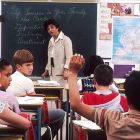Parents Experimenting On Their Children in Fiction

[General spoiler alert, and specific sub-alert for We Are All Completely beside Ourselves, which contains a big reveal midway through the book]
It’s unsurprising that parenting is fertile ground for novelists, given that the parent–child relationship is one of the most intense. There are plenty of stories, both in fiction and in real life, of parental sacrifice for the sake of children. More surprising are the accounts of parents using their children for the sake of their work.
A surreal version of this comes from Katharine Dunn’s Geek Love, about a family of circus sideshow performers. To ensure their children’s professional viability in the circus geek world (and to keep the family closely knit by virtue of their oddities), Al and Crystal Lil Binewski experiment with a variety of substances before Lil gives birth. Their hope is to produce children with interesting and marketable deformities. Lil asks rhetorically, “What greater gift could you offer your children than an inherent ability to earn a living just by being themselves?”
This is twisted and extreme, yes, but it’s also an extension of things many parents do: 1) push their children into the family business; and 2) alter their children’s bodies (whether through ear piercing, circumcision, foot binding, or the like) to align with their cultural expectations.
Of course, in the Binewskis’ case, these physical modifications have health implications for their kids. Arty (Aqua Boy) is born with flippers. Electra and Iphigenia are Siamese twins. Chick is telekinetic. And Oly is disappointingly “normal,” as the family considers being a hunchback albino dwarf to be.
But these kids frequently express pleasure with their unique bodies, rather than longing for normalcy. The book is full of tragedy, and it’s clear that the Binewski parents are misguided in turning their unborn children into pharmacological guinea pigs. Yet tragedy and misguidedness are common traits of parents. Is the difference just in how far the Binewskis are willing to go?
In John Burnside’s menacing The Dumb House, the parent in question does not have his children’s best interests at heart. This lifelong psychopath is obsessed with language and curious about how language is learned. Not content with speculation or academic study, he turns his home into a kind of chilling linguistics laboratory to find out. This involves subjecting his twins to linguistic and physical isolation, never speaking to them in their basement prison. He sees this as important work, calling it “the single most important experiment that a human being can perform: to find the locus of the soul, the one gift that sets us apart from the animal; to find it, first by an act of deprivation and then, later, by a logical and necessary destruction.”
As if to argue that language will always find a way, the twins eventually develop a form of communication through singing, which maddens their father. Acknowledging his experiment as a failure, he cuts out his children’s vocal cords and poisons them. He resolves to try again with the latest vulnerable woman he intends to impregnate.
It’s difficult to gain much parenting insight from this portrait of unflinching madness. There’s a reason, after all, that deliberate language deprivation has been called “the forbidden experiment.”
Yet there are a number of real-life cases of linguists using their children in their work—in much less sinister ways. In the “Human Speechome Project,” MIT professor (and later chief media scientist at Twitter) Deb Roy filmed and audio-recorded his son for three years, ten hours a day. The intention was to learn as much as possible about the language learning environment, and a natural home setting was key to that.
The heavy surveillance of a child stirred up some controversy, but Slate points out that there’s a long legacy of linguists and others using their children in observational studies. Recording your kid’s words may seem harmless, so what is it about the logical extension of this to technology-enabled surveillance that seems disturbing? Academics and the general public may have different ideas about the ethical boundaries are for incorporating children—and anyone who can’t give full consent—into parents’ research.
A novel that more closely corresponds to real life is Karen Joy Fowler’s We Are All Completely Beside Ourselves. Much of the book consists of reflections on familial responsibility, in light of the narrator’s mysterious estrangement from her two siblings.
We eventually learn that Rosemary’s sister, Fern, is a chimpanzee, who was raised alongside humans in a study of how close these primates are. This reveal is handled more gracefully than the abrupt synopsis here might suggest, for Fern is a well-rounded character who was in many ways a sister like any other. Rosemary and Fern grew up together, in the same house, with parents who made a scientific mission out of treating their children the same. The girls hit many of the childhood milestones together, even if Fern outpaced Rosemary in terms of climbing skills. And they had the usual sibling rivalries—compounded in this case by the extra attention Fern receives from grad students and others, which makes Rosemary as irrationally jealous as a five-year-old can be.
One tragedy precipitated by the parents’ decision is the failure to recognize that a chimp has certain traits that can’t be ignored in an attempt to smooth out her seeming humanness. Fern has great strength that she has a hard time controlling, for instance. The Cookes’ decision to send Fern away to a research lab is traumatic for everyone. Son Lowell reacts by becoming a fugitive for animal rights, for instance. In degrading captivity, Fern herself is suspended between the worlds of chimps and humans, neither of which accepts her fully.
Another of the many fascinating aspects of the book is the sense that all three children were participating in their psychologist father’s experiment: The question was not just whether Fern would consider herself one of the family, but also whether Lowell and Rosemary would view Fern as one of them. Even their mother might have been part of the experiment—to assess the extent of the maternal instincts a human could develop for a chimp.
The plot might seem ludicrous if not for the fact that it was briefly trendy in the 1970s for social scientists to raise chimps as humans, to generate data on child and language development. Among the best-known of these chimp children/subjects is Nim Chimpsky, who became so adept at sign language that he eventually communicated “stone smoke time now” to a weed-smoking researcher.
We Are All Completely Beside Ourselves nods to the wider trend of bringing chimps into homes. Rosemary comments,
We were not the only household during this period attempting to raise a baby chimpanzee as if she were a human child. The aisles of the supermarkets in Norman, Oklahoma, where Dr William Lemmon was prescribing chimps liberally to his grad students and patients, were full of such families.
Curiosity is of course a common trait of the parents in these three books. Exploitation of children is another, made poignant by the fact that the children’s parents are the ones subjecting them to experimentation.
While the parents in the novels go to extreme lengths while treating their children as a dataset, all three books point to a truism that extends beyond cases of excessive experimentation. That is, the best interests of a child are clearly too important to be left just to the parents.



